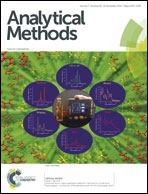A highly sensitive electrochemical DNA biosensor for rapid detection of CYFRA21-1, a marker of non-small cell lung cancer
Abstract
Many studies have confirmed that CYFRA21-1 is both a sensitive and specific marker for non-small cell lung cancer (NSCLC), in particular, squamous cell carcinoma. Therefore, methods to detect CYFRA21-1 are sought to enable early diagnosis. In this manuscript, we report a simple, effective, and convenient method to detect CYFRA21-1 using a novel electrochemical DNA biosensor based on a nanocomposite consisting of carboxyl-functionalized graphene oxide (GO-COOH) and copper oxide nanowires (CuO NWs). The nanocomposite is highly conductive, and was characterized by scanning electron microscopy, transmission electron microscopy, and cyclic voltammetry. Differential pulse voltammetry was also applied to monitor DNA hybridization, using methylene blue as an electrochemical indicator. Under optimal conditions, the biosensor is highly sensitive, with a low detection limit of 1.18 × 10−13 M (at S/N 3). Indeed, CYFRA21-1 could be quantified with good linearity (R2 = 0.9750) from 1.0 × 10−12 to 1.0 × 10−6 M. The sensor has good stability and selectivity, and discriminates between ssDNA sequences with one- or three-base mismatches. PCR-amplified CYFRA21-1 from a clinical sample was successfully detected, indicating potential application of the biosensor in clinical research and practice.


 Please wait while we load your content...
Please wait while we load your content...